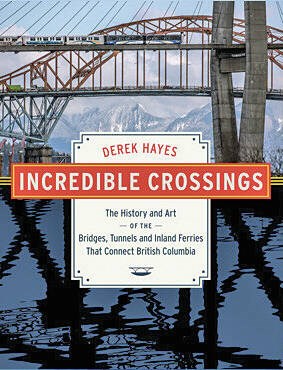Incredible Crossings: The History and Art of the Bridges, Tunnels and Ferries that saąúĽĘ´«Ă˝ British Columbia
By Derek Hayes, Harbour Publishing; 320 pages, $46.95
At one time, many years ago, Bridge Street in the Rock Bay area of Victoria actually led to a bridge, one that connected the north side of the bay with Store Street on the south side.
That bridge was to the east of the one at Point Ellice, which in 1896 was the site of the worst street car accident in North America. On May 26 that year, an overloaded car travelling to Esquimalt for Queen Victoria’s birthday celebrations crashed through the bridge, and 55 of the 143 people on board were killed.
The first bridge on that site had been built in 1859, but was removed because it impeded marine traffic. Its replacement was higher, but was not built for the weight of street car traffic. After the accident, the bridge was rebuilt in 1903. It was replaced in 1957 by the current bridge, which moves Bay Street traffic to and from Vic West.
For years, the most well-known bridge in Victoria has been the one at Pandora Avenue and Johnson Street. The first crossing there was a wagon bridge built in 1855, but since it blocked navigation it was torn down in 1862 and replaced with a ferry.
The second bridge was a railway bridge, although pedestrians could cross it. The bridge was a swing bridge, which meant it could open to make way for boats to pass.
The next bridge there is the one that became known as the Blue Bridge. It was officially opened in 1924 after several years of debate, controversy and finally planning and construction. The bridge was designed by Joseph Strauss, who went on to design the span that crosses the Golden Gate in California.
The next bridge — the one that stands today — opened in 2018. It is almost five years old, and is only 90 years away from matching the record of the Blue Bridge.
This is a taste of the information that you will find in Incredible Crossings: The History and Art of the Bridges, Tunnels and Ferries that saąúĽĘ´«Ă˝ British Columbia, the latest book by historian and geographer Derek Hayes.
You’ve probably seen his work before; over the past couple of decades, Hayes has produced a not-to-be-missed series of books on historical maps.
There are hundreds of high-quality photos, old and new, in black and white and in colour. They help to tell the story of how British Columbia’s rivers and mountain ranges were crossed as the province’s transportation network was developed and expanded.
Hayes says that saąúĽĘ´«Ă˝ has 3,000 bridges today.
These links are absolutely crucial, as we were reminded in November 2021, when the extreme rainfall cut the highway links in the Coquihalla, Nicola Valley and Fraser Valley areas. Yes, Hayes includes photos of the damage done, and the repairs that were made remarkably quickly.
Incredible Crossings has a heavy emphasis on the Lower Mainland, with the various bridges over the years shown and explained in great detail. That emphasis makes sense, to a certain extent, because the Lower Mainland is where most British Columbians live, and readers there make up a key market.
But there are stories from Vancouver Island and the Interior that are every bit as engaging.
A case in point: The bridges along the Trans-saąúĽĘ´«Ă˝ Highway in the Interior, including the ones that were single-lane spans for alternating traffic until the 1970s.
The road along the Kicking Horse River east of Golden, the scene of massive work for the past couple of years, could have been given much more attention.
And let’s not forget the old Bailey bridges, which were essential in the Interior in the 1950s and 1960s. They were found on many highways until the government got around to putting permanent spans in place.
Bailey bridges were prefabricated, lightweight spans that could be quickly put into use when needed. One of the most notable instances came in 1966, when an ice jam at Smithers took out two-thirds of the bridge crossing the Bulkley River.
The washout happened on April 8, leaving a gap of 100 metres. Thanks to Bailey bridge units and a devoted crew, the highway was reopened on April 21.
That nugget is not in Incredible Crossings, sad to say — but perhaps it can give Hayes a head start on his next project.
In the meantime, we have this superb volume. Hayes has a record of producing high-quality books, and with Incredible Crossings, his record is intact.
Reviewer Dave Obee is the editor and publisher of the saąúĽĘ´«Ă˝



